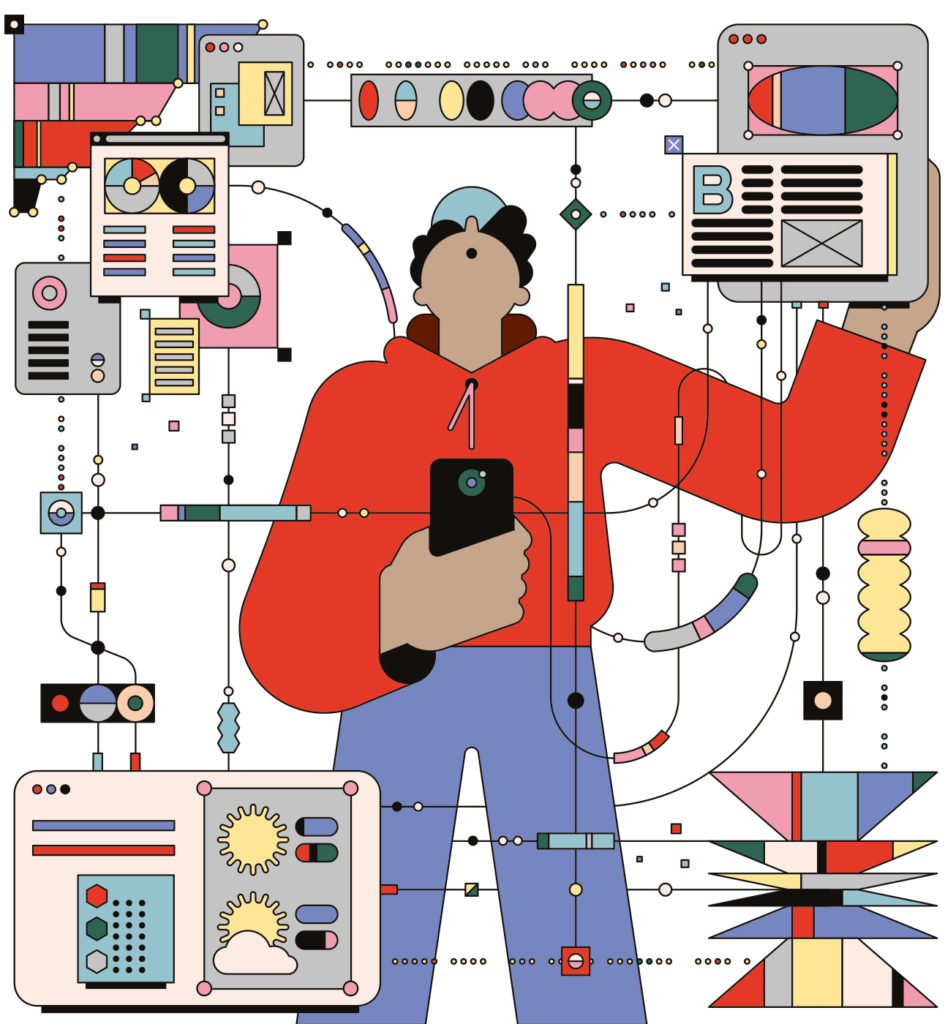Presentation in the College of the Arts Fall 2023 Research Lightning Round, University of Florida.
Abstract: Algorhythms are computer instructions that display recurrent logic and rhythm. They are introduced in our everyday life through digital technologies to structure our activities. The Theater of the Techno-Oppressed is a research program aimed at exploring the role of algorhythms in disrupting body rhythms. The presentation shares insights from experiences with Theater of the Oppressed, a technique pioneered by Augusto Boal, and its applicability to studying the societal impact of technology. An engaging “Everyday Dance Game” exercise is presented to prompt participants to reflect on the rhythms imposed by technology. Crucial questions are raised regarding the relationship between digital technology and the human body, those responsible for shaping these rhythms, and how accountability can be established to foster more democratic and liberating technological experiences.
Video
Audio
Full transcript
Hello everybody. This is Fred. I’m still a fresh new faculty member. I just arrived from Brazil three weeks ago. I’m still trying to find my place, not just in Florida, but also at the University and at the College of the Arts. So it’s really great to be here today and meeting all of these researchers. Usually, design researchers have one foot set in the Engineering side or on Social Sciences, and the other foot they have set in the Arts. Graphic designers mostly set foot in the Fine Arts. But I’m this strange guy who set foot in Theater. And you will understand why very soon.
I’m quite interested in the design of digital technologies and the social and emotional impact of those technologies in our everyday lives. I study this topic through the framework of oppression studies, especially the Latin America branch that people like Paulo Freire have pioneered. One of his collaborators was Augusto Boal, the creator of Theater of the Oppressed.
For those who are not aware of what I’m talking about, I’ll try to connect with this presentation with a very simple memory. Those times during the pandemic, once we felt like your whole body rhythms changed because of the technologies we must rely upon for keeping up with your everyday lives. We intensified their usage even, as if we were already using it too much. We were certainly overdoing it. We then felt those rhythms and algorithms in our skin, those logical rhythms that these technologies embeds. They targetted our bodies directly. Perhaps you can relate to that or not: I was not able to sleep well because all my circadian rhythms had been messed up by these technologies. They kept pumping messages to my eyeballs and drawing my attention, my interest, and my motivations to always check the screens for reaching out to other people.

This has been conveyed very nicely by a graphic designer called Bratislav Milenkovic. This kind of graphic design are static representations of a dynamic phenomenon. This is not exactly what I’m interested in. Although I like graphic design representations of these complex situations, I prefer something more fluid that adds time to the representation, especially that adds the chance to change what we are representing so that representation is also politically engaged with the transformation of reality. That’s why I moved to Theater.
If you felt like me during the pandemic times or in any other situation where technology was bringing you foreign rhythms messing up with your self-body consciousness, welcome to the Techno-Oppressed Group, a group that I would love to recreate at the University of Florida. I am still trying to find peers to share this kind of research project.

Here you see how I learned Theater of the Oppressed at Centro do Teatro do Oprimido in Rio de Janeiro, a center that was founded by Augusto Boal, the creator of this approach in the 1980s. And I’ve been attending courses regularly there for almost 10 years. In this particular picture, you see how it works. We represent an oppressive interaction, everyday oppressive interaction. Here I’m playing out the role of a man, a sexist man, who’s harassing a woman who feels like he has the right to approach women in that abusive way. I am being protected by other oppressive men, men who think that the world centers around male power and they feel like this is moral, although for the women this is immoral. After that, not shown in this picture, women try to react to that oppression and counter the oppressor.
Theater of the Oppressed has been experimented with in many different areas, many different kinds of oppression, not just sexism, but also work exploitation, racism, and the like. I’m interested in adding to Theater of the Oppressed a closer look at the role of technology in mediating, either amplifying or fighting oppression. I see technology in this arena of dispute for who can define its purposes and designs, this process where technology’s purpose is becoming materialized into functions, but also in the appearance of form. Digital technology, like Theater, has a timely form, a form that manifest in time like a movie or a song.

In this picture, it is possible to see the interaction happenning through time. There is an everyday technology in the middle, the Artificial Intelligence feed sorting news for you. The AI has a bias towards showing you shocking news. Yes, it’s no coincidence that you see mostly shocking news in your feed. The AI has this bias towards frustrating you so that advertisers can take the opportunity to show you some products that can build up on your fragilities. We discovered this bias through these laboratory theater sessions in an embodied way. We are not just criticizing this technology through academic discourse; the participants in this group discover that by interacting and replaying those algorithms, by incarnating them in their interactions, they can raise many hypotheses. I don’t have time to go through all of them, though.
I prefer to do a rapid experiment with you if you would like to join me. Can we perhaps become less oppressed by dancing our algorithms? I’m playing out with the word “algorithms”, which usually is written with an “I”. I replace the “I” for “Y” because I’m interested in seeing algorithms more concretely, more physical, and how they affect our body rhythms. Here is the game that if you would like to play out, you can join. I’m not able to join this game because I’m going to play out the instructions, but if you would like, you can open your camera and you can play out the game, or you can just close your eyes and imagine you playing the game. Feel free to do so. It’s not really very good to do that online, like we’re doing remotely here, using this kind of technology that has a bias towards a rhythm that is not really socialized. It looks like we’re socializing, but well, it’s not quite there. Anyhow, that’s what we’ve got and we will make the best of it.
We will try to hack these technologies through this kind of theater game. This is called “Everyday Dance Game”. If you are playing, please close your eyes first and then try to remember what you were doing yesterday at this precisely the same time of the day. What were you doing? Were you working? Were you at home? Were you with your friends? Were you some other different people? Was there an animal next to you? Now you try to move your body to grasp the rhythm of that activity at the precise time yesterday. Try to be repetitive as much as the activity was.
All right, go ahead now and think about what were you doing before that activity, the very same activity before that, and do again new movements, new movements that are related to that activity. Now I ask you to advance further to the very late moment after the activity that you were doing precisely at this time yesterday. Advance further to the next activity and do the same. Now you have to reenact those movements, those repetitive movements, and now finally you combine all the movements into a dance. You can open your eyes and check out what other people are dancing on your screen.
I can see there’s a lot of people typing. Some people are using a cell phone or even other kinds of technologies, a car for example. Indeed, many people were driving. What this exercise reveals is that there are a lot of rhythms that have been designed by someone else who’s not just us, right?
I’m not going to go through the research questions of this research project in length. I want to share just three of them. I’m not going to touch upon the methodologies so that you can better think about how profound are these questions. What is the impact of digital technology on our bodies and conversely how do our bodies also impact those digital technologies? We are surely part of this process of defining our everyday algorithms, but who are the percussionists? Who set the tone? Who set the rhythms? And what do they want from us? What are their intentions? Their political agendas? Their marketing interests? I don’t know. That’s something we need to research and look more closely.
Dance and Theater are both very interesting approaches for learning about something that through any other means we can’t scrutinize. Finally, that’s the most interesting political question, how can we own those algorithms and hold us percussionists accountable and publicly scrutinize them so that society can design its own rhythms in a participatory, democratic perhaps, and liberating way? That’s it for now. Thank you very much.

